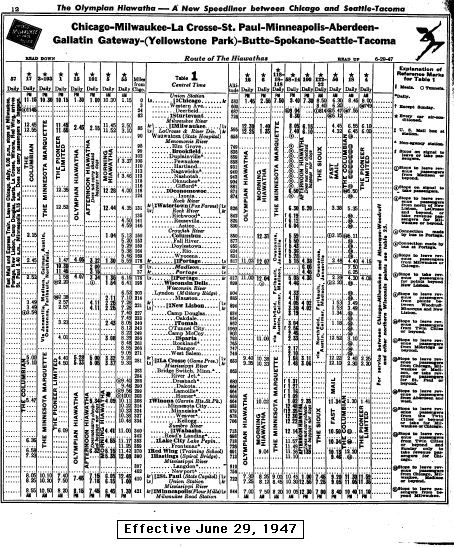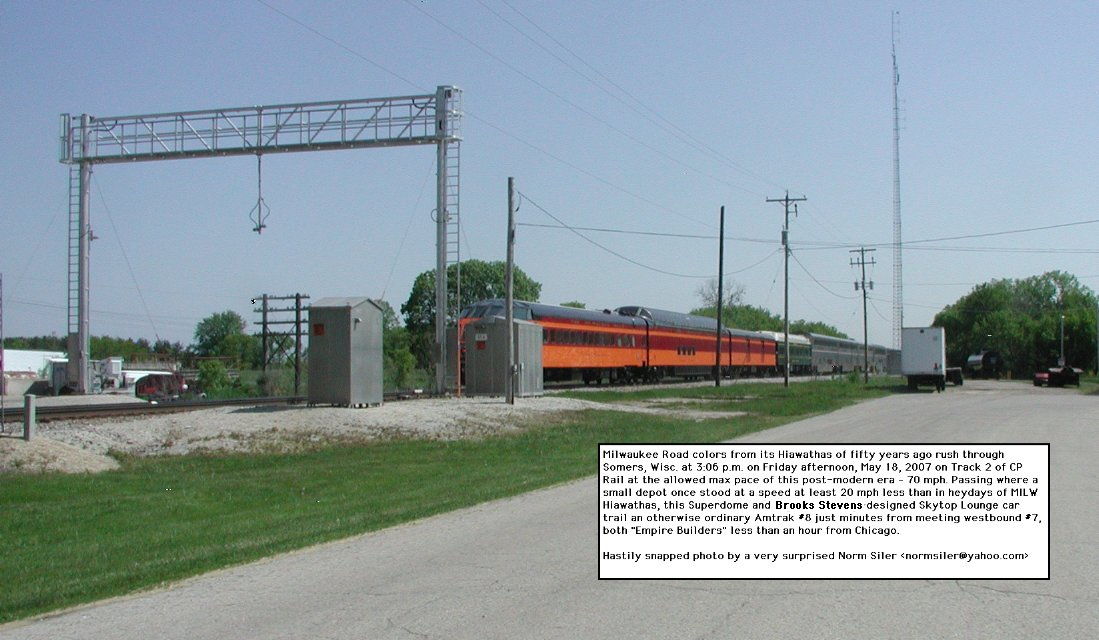Return to KenRail homepage
Read memories of high speed trains
While memories are fading about the former pre-eminence of train travel in the U.S.A. and of the prominent place Wisconsin routes held in the speed annals of the nation, an occasional reminder surfaces which puts into perspective the degree of decline suffered by railroads and by the passenger trains they once employed as symbols of their corporate excellence.
Chicago, Burlington & Quincy RR enjoyed the shortest route between Chicago and St. Paul, Minn., and further gained by its mild gradients and long stretches of multiple tracks for diesel-powered Zephyrs, a pioneering motive power technology in the 1930s combined with innovative stainless steel coaches. The "Burlington Route" prided itself on its achievements and on its inventive workforce.
Chicago & Northwestern Railway staked its reputation on 400 Streamliners traversing 400 miles in 400 minutes ( 6:40 ), achieving renown in its own right for utilizing refitted heavy-weight coaches behind its best, its fastest steam locomotives to stop at seven intermediate stations while also maintaining a demanding schedule. A Time magazne story in 1935 sketched the startling achievement. In fact, C&NW operated perhaps the most demanding schedule because C&NW's route was single track for more extent than any Chicago-Twin Cities competitor, a constraint placing the highest priority on each train arriving on-time at its schedule meeting siding. (Failing to reach a meeting point on-time places an inordinately heavy time penalty on the tardy train, if the meet is changed by the dispatcher, or on the on-time train, if the schedule meeting station is unchanged. In either situation, the tardy train's crew was sharply chastised, and sometimes disciplined, merely for falling behind schedule.) Like its two speed antagonists across Wisconsin, the "Northwestern" staked its pride on its #400-401 trains, as well as naming a variety of lesser trains with some form of 400 title (e.g. Flambeau 400 to Woodruff, Dakota 400 to Rapid City, S.D.) despite more leisurely schedules.
Two smaller companies also operated between Chicago and the Twin Cities. But neither Chicago Great Western (via Oelwein, Iowa) nor Soo Line (via Stevens Point, Wisc.) engaged their larger competitors in speed contests in order to lure passengers. Nor did Chicago, Rock Island & Pacific RR compete; the "Rock Island" served both metropolises, but lacked a route of its own, except via Des Moines, Iowa.
None of those railroads matched The Milwaukee Road for corporate commitment to pure speed, to coaches meant to show the world -- and the traveling public, more than competitors -- that 410 miles would not cause its passengers to arrive later than any others. Milwaukee Road invested in locomotives and tracks able to rush trains for mile after mile at speeds above 100 mph. The heyday of Hiawathas began in the 1930s in response to Burlington diesel-power, in defense against the Northwestern mile-a-minute average. Both competitors enjoying shorter distance than the MILW in the Chicago-Twin Cities travel market.
With the end of global war in 1945, The Milwaukee Road (formally incorporated as Chicago, Milwaukee, St. Paul & Pacific RR) set about asserting anew its access to the Pacific Northwest and to the "Orient" markets prized as far back in time as Christopher Columbus. And, it set about publicizing its excellence and market access with an Olympian Hiawatha train, named for the state of Washington mountain range shielding Puget Sound and its ports from weather unchecked for thousands of miles
So peruse this 1947 schedule of Milwaukee Road passenger trains, with Chicago-St. Paul travel elapsing in just 375 minutes ( 6:15 ) for 410 miles, with five intermediate stops, knowing that high speeds across Wisconsin are nothing new for this state nor for towns along the way. Rather, 100-plus mph speeds have merely faded along with the quest for excellence which once propelled entire companies to strive intensely, in competition with other railroads and with burgeoning legions of automobiles.

Return to KenRail home page Visit Wisconsin Dept. of Transp'n project website
Chuck Burmeister remembers: "My wife was born amd raised in Sparta, Wisconsin. I spent several years in the reserves amd 40 years going back and forth to Sparta. I will always remember a sign along the Milwaukee Road tracks ... announcing that you should beware of trains going 100MPH! I believe that the sign is still there today but faded out from the weather.
"I can remember seeing the 100 mph sign many times over the years. It was and probably still is there."
For more than twenty years, Milwaukee Road Hiawatha passenger trains championed the railroad company's image as a fast, pace-setting, technology-pioneering carrier of people and freight.
As the wane years of the Great Depression reached their depths, local lore among farmers and towns folk near the busy pair of C & M Subdivision tracks between Chicago and Milwaukee described speeds of newly steam-powered maroon and orange Hiawatha trains routinely topping the century pace of 100 mph. After World War II, federal regulations imposed signalling standards and then a 90 mph speed limit for the competing railroads hastening passengers between Chicago and the Twin Cities. By the late-1950s, the 90-per pace was seldom topped, but "making up time" remained a respected practice among some locomotive engineers. Certainly, MILW had its share, and no place better to stretch out the slack on maroon and oranges coaches than along the ten-plus miles of tangent track between Truesdell and MP 63, north of Sturtevant.
Somers, at MP 57.6, was too small a staton to merit a stop for Milwaukee Raod passengers, but the non-stop trains of that bygone era made all the deeper an impression among residents for the speed they passed, day and night.
The photo below is symbolic in several ways of the transformation to current practice. Amtrak Empire Builder eastbound from Milwaukee was 13 minutes late departing, and a headlight approaching Somers at 2:42 p.m., 14 minutes later and 28 miles along its route, was a lengthy CP Rail symbol freight hammering southward at flank speed. The headlight of Amtrak 61 appeared only at 3:06, and was gone as quickly as it appeared -- no doubt never catching a signal behind the cargo hauler busily paying the bulk of CP Rail bills.
An excellent website at Trainweb, Milwaukee Road Online, portrays numerous Hiawatha scenes, behind steam and diesel locomotives.
Milwaukee Road passenger cars operated through some of America's most scenic terrain, and are detailed at this Trainweb set of web pages.
Milwaukee Road Historical Association web site.

Return to KenRail home page